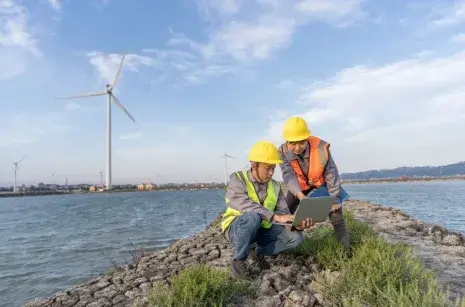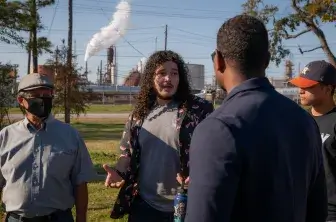Strategy 3: Mobilize Investment
Replace Aging Infrastructure

Low-wealth communities have a concentration of old and polluting infrastructure that needs replacing, including across energy producing facilities, the electrical grid, and transportation. Building new construction in these areas can help create thriving and resilient communities and reduce injustice.
More recommendations
Much of new climate-related spending, such as through the recent Infrastructure Investment and Jobs Act, will go toward infrastructure projects related to energy, clean industry, and resilient buildings. These new investments are an opportunity to bring resources to communities that have experienced historical underinvestment. Polluting industries with disproportionately high greenhouse gas emissions are frequently located among marginalized communities, so these investments have simultaneous benefits for climate, human health, environmental and social justice, and local economies.[i]
The electricity grid is one promising area for infrastructure modernization that increases equity. Local conditions of the grid determine the ability of the grid to take on renewable resources, thus perpetuating historical underinvestment by keeping older, more polluting energy sources near the poorest communities with underinvested grids. Prioritizing investment in frontline communities through identifying local infrastructure gaps builds a more equitable, less polluting, and more resilient grid.
Support for modernizing infrastructure can come from government incentive programs to redevelop communities unduly impacted by pollution. Many business owners the Commission spoke to identified tax credits and state-administered rebates as key to enabling infrastructure improvements in frontline communities.[ii] Recent executive actions have also created new opportunities to connect frontline communities with funding. The Justice40 Initiative mandated that at least 40 percent of federal climate investments go directly to frontline communities. Justice40 recommends the creation of screening tools that identify underresourced communities and set funding guidelines to improve economic conditions and protect against climate impacts.[iii] One such tool, the Climate and Economic Justice Screening Tool features an interactive map identifying communities experiencing different categories of environmental and economic burdens. Publicly available and continuously updated with new data, this tool can direct private sector spending to communities at the greatest risk and with the most to gain. For example, the screening tool helped fund the EPA’s Clean School Bus Program, which is replacing 2,600 school buses with electric alternatives in frontline communities.[iv] Many other large federal agencies have already drafted and are beginning work on Justice40-covered programs.
In addition to the large federal projects covered by Justice40, community-led organizations should be funded directly to identify and support local projects. Public funders such as the EPA’s Environmental Justice Thriving Communities Grantmaking Program and private grantmakers such as the Climate and Clean Energy Equity Fund or the Building Equity and Alignment Fund provide millions of dollars annually to nonprofit grassroots organizers. These grantmakers also support local capacity-building by providing technical assistance and sharing strategies for economic development with grantees. Similarly, the DOE provides funding and technical assistance for municipalities and community organizations to implement energy efficiency and weatherization programs in all fifty states and U.S. territories.[v]
[i] Susan Perlin, David Wong, and Ken Saxton, “Residential Proximity to Industrial Sources of Air Pollution: Interrelationships among Race, Poverty, and Age,” Journal of the Air and Waste Management Association 51 (3) (2001), https://doi.org/10.1080/10473289.2001.10464271.
[ii] American Academy of Arts and Sciences, Barriers to Private Sector Action (Cambridge, Mass.: American Academy of Arts and Sciences, 2022), https://www.amacad.org/publication/barriers-private-sector-action.
[iii] Colleen Callahan, Daniel Coffee, J. R. DeShazo, and Silvia R. González, Making Justice40 a Reality for Frontline Communities: Lessons from State Approaches to Climate and Clean Energy Investments (Los Angeles: Justice40, UCLA Luskin Center for Innovation, 2021), https://innovation.luskin.ucla.edu/wp-content/uploads/2021/10/luskin-justice40-final-web-1.pdf.
[iv] U.S. Environmental Protection Agency, 2023 Clean School Bus (CBS) Grant Program: Notice of Funding Opportunity, EPA-OAR-OTAQ-23-06 (Washington, D.C.: U.S. Environmental Protection Agency, 2023), https://www.epa.gov/system/files/documents/2023-04/2023-csb-grant-nofo-4-20-23.pdf.
[v] Office of State and Community Energy Programs, “State and Community Energy Programs Project Map,” U.S. Department of Energy, https://www.energy.gov/scep/state-and-community-energy-programs-project-map (accessed June 12, 2023).





